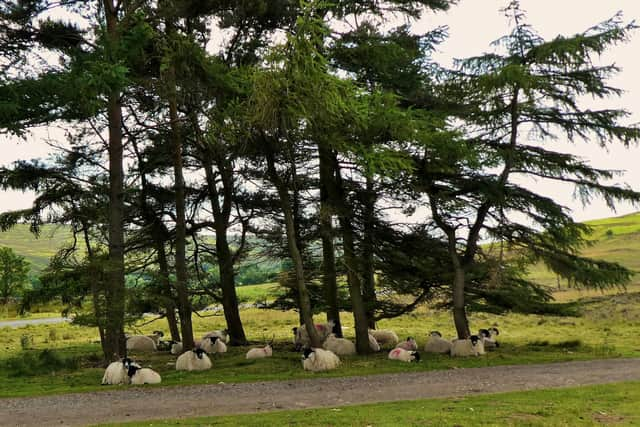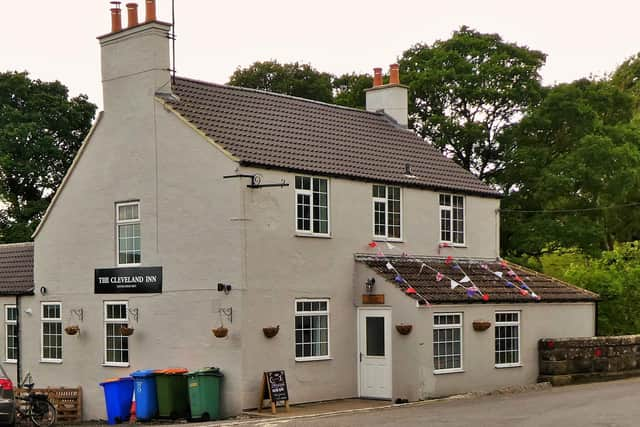Stroll With Stu: try this 5.5-mile walk around Commondale on North …

 Sheep in Commondale.
Sheep in Commondale.
Starting at the railway station, head up its little access path, through gates at the top to turn right along the wide track heading towards Castleton.
It winds left, uphill and right but after a wooden gate and then a memorial bench - in memory of Chris Edwards and his beloved Gordon Setter dogs - look out for a marked gate set back on your left.
The unclear path climbs relentlessly uphill, eventually through a missing gate and ultimately to a crosspath where you should turn sharp left to descend on a path (sometimes a stone trod) beside a stone wall, to emerge in front of the very lovely Cleveland Inn (more of which, later).

 Sheltering sheep.
Sheltering sheep.
Commondale dabbled with ironstone mining for a short while, but the deposits weren’t about to make anyone a fortune and the endeavour only lasted 10 years or so.
However, that was long enough to build the line of white miner’s cottages on a hill above the village which remain prominent and visible for miles around.
It is more famous for its large brickworks that existed for many years, before closing in 1947.
The distinctive red bricks were used in many buildings around the village and you may want to take a stroll around before heading for the hills.

 Whiteley Beck, from Thunderbush Moor.
Whiteley Beck, from Thunderbush Moor.
Carry on along the road signposted for Kildale.
At the brow of the hill, after the tractor shed on your right, follow a signpost right along a path that edges down to a gate stating “no bikes”.
Go through that and follow the path into some pretty new woodland.
Nice to see many young oak saplings among the mix.

 The Cleveland Inn, Commondale.
The Cleveland Inn, Commondale.
A stone slab amounts to a footbridge across Whiteley Beck, after which the path climbs up through a gate to open moorland.
Continue for a mile or more on the right side of the valley, with North Ings farm down to your left.
With skylarks ascending on a hot breeze direct from the Sahara, I rested to ponder a question that has puzzled me for years.
On this sort of terrain in Scotland, you are likely to be accompanied by clouds of vicious, tartan clad midges while their softer cousins and a variety of flies in North Yorkshire[1] will compete with your hat for a place on your head.
My question is, what do they live on when there are no walkers around?
Why, if they love you so much, don’t they move house?
Do they starve for days on end until a lonely hiker emerges from the Whitby train?
And if they pester the local sheep, why can’t they just stay there?
Answers on a postcard…
A reassuring waymark leads you on up the valley, soon meeting a much wider track, where you can turn sharp left to head down towards the farm.
The path diverts left in front of a “you can’t come in, mate” gate, to follow a wall around to the right, then dropping steeply right through a marked gate into some rampant bracken, and on to a footbridge across the beck, which curiously now seems bigger than it was further down the valley.
Climb up and left, to rejoin the wide track, heading left towards Commondale.
There are beautiful views ahead from the exquisitely named Thunderbush Moor, though Commondale village has largely disappeared behind the trees.
Slightly less pretty are the compendium of traps straight from a rural pest control catalogue that litter the area, though as I am a townie, presumably I don’t understand.
On reaching the road turn right, then quickly left (alongside a wall beyond gorse bushes) to a gate into a grassy field.
A dire warning on the gate about rampaging cows only resulted in a hostile stare from several tons of brisket as I skipped slightly more quickly down to another gate.
After that, the field boundary is now on your left, leading to a further gate and a wider track.
Turn left along a road, with the rail bridge to your right, past the ramparts of a second rail bridge which I think carried a line up to those old brickworks.
Then, it’s a simple half mile walk along the road back up to the Cleveland Inn for refreshments on a very hot and steamy day.
I got there just as the skies
turned inky black - as promised by the met office – and was happy to watch the rain from within.
Commondale is a lovely little village, with resident ‘wild’ chickens, a fascinating history and a welcoming pub with a brookside beer garden, that is reliably open all day, every day, in the summer.
Another solid recommendation from the Stroll with Stu column.
References
- ^ North Yorkshire (www.thescarboroughnews.co.uk)